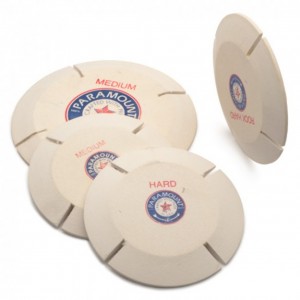The wool felt wheel, a long – standing staple in the polishing and finishing industry, is undergoing a remarkable transformation thanks to recent technological breakthroughs. These advancements are not only enhancing the performance of wool felt wheels but also expanding their applications across various sectors.
One of the most significant technological developments is in the manufacturing process. Advanced felting techniques are now being employed to create wool felt wheels with more consistent density and structure. This results in wheels that offer more uniform polishing performance, reducing the occurrence of uneven finishes. Computer – controlled manufacturing systems ensure that each wool felt wheel meets precise specifications, guaranteeing high – quality and reliable products.
In terms of material science, researchers are exploring ways to improve the properties of wool fibers used in the wheels. Through treatments and enhancements, wool fibers can now exhibit increased durability and resistance to wear. This means that wool felt wheels can last longer, reducing the need for frequent replacements and ultimately saving costs for users. Additionally, new bonding agents are being developed to improve the adhesion between the wool fibers and the backing material, ensuring that the wheel remains intact during use.
Another area of innovation is in the design of wool felt wheels. Manufacturers are creating specialized wheels for specific applications, taking into account the unique requirements of different materials and tasks. For example, in the electronics industry, where precision is crucial, there are now ultra – fine wool felt wheels designed for polishing delicate components such as circuit boards and microchips. These wheels are engineered to provide a gentle yet effective abrasion, preventing damage to sensitive parts.
The integration of smart technology is also starting to make its mark on wool felt wheels. Some manufacturers are experimenting with embedding sensors in the wheels to monitor factors such as temperature, pressure, and wear during use. This data can be used to optimize the polishing process, ensuring that the wheel is used at its optimal performance level and alerting users when it needs to be replaced. Such smart wool felt wheels have the potential to revolutionize industrial polishing operations, increasing efficiency and reducing waste.
These technological advancements are having a profound impact on the industries that rely on wool felt wheels. In the aerospace sector, where the highest standards of quality and precision are required, the improved performance of wool felt wheels is enabling better finishing of aircraft components. This not only enhances the appearance of the components but also contributes to their aerodynamic efficiency and durability.
In the woodworking industry, the new generation of wool felt wheels is making it easier for craftsmen to achieve professional – level finishes. The more consistent polishing action allows for smoother sanding and buffing of wooden surfaces, enhancing the natural beauty of the wood.
As the technology behind wool felt wheels continues to evolve, we can anticipate even more exciting developments in the future. These could include further improvements in material performance, more advanced smart features, and the creation of wool felt wheels for previously unexplored applications. The reinvention of the wool felt wheel through technology is set to shape the future of the polishing and finishing industry for years to come.

Post time: Jun-11-2025
